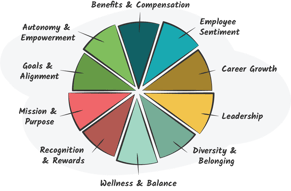Have you ever dreaded completing a task? Of course, you have. You're human. This is a pervasive experience.
You dread completing the task, not because you can't do it, you're just not interested.
In short, you don't feel invested, so your productivity and effort suffer as a result.
Chronically lacking the motivation to complete your job is a problematic experience for both employees and management.
When employees don't feel invested
At work, many factors influence our motivation and investment in our jobs.
Elements such as work-life balance, management, clarity around goals and mission, and career growth are just a few examples of the key drivers of engagement. They are, in extension, the building blocks of a strategic employee engagement program.
In this article, we will look at the two drivers of employee engagement that impact productivity specifically:
- Recognition and gratitude
- Work-life balance
By prioritizing recognition and work-life balance, you will inspire employees to feel happier and emotionally invested in their jobs. Higher productivity will follow as a natural result of improved satisfaction and morale.
The Power of Recognition and Gratitude
Let's follow a new employee in his first year of tenure to see how recognition and appreciation are vital to keeping employees engaged and productive.
Let's call this new employee, Charlie.
Charlie is a diligent and motivated employee, still early in his tenure at the widget company. He has a lot of internal drive and motivation to perform. He starts his tenure off strong. Working hard and delivering excellent results.
After a few months of hard work, Charlie's efforts go unrecognized. Behind the scenes: Managers are busy, stressed and overworked.
Charlie is working hard to get results, but does anyone notice or care? He doesn't seem to think so.
Moreover, an ego-driven, competitive attitude characterizes this workplace's culture. Management overlooks candid communication, collaboration, and gratitude. As a result, busy supervisors only make time for praise during formal evaluations, a handful of times a year.
The months go by, and Charlie continues to put in the same effort, but the lack of recognition continues.
 As the basic need for appreciation goes unmet, Charlie begins to feel detached from his work. Starting a task that used to be simple and straightforward has now become a mental obstacle. He procrastinates over his daily responsibilities and functions.
As the basic need for appreciation goes unmet, Charlie begins to feel detached from his work. Starting a task that used to be simple and straightforward has now become a mental obstacle. He procrastinates over his daily responsibilities and functions.
Why bother going above and beyond when no one notices or appreciates it, he thinks.
In the final stages, he begins to experience depression-like symptoms. He not only dreads his tasks but going into work altogether; he is now staying home more often or leaving work early.
Eventually, full disengagement occurs, and he quits his job before his first anniversary.
Recognition: A low cost, high-impact solution
As our opening story of the fictional employee, Charlie illustrates, never underestimate the power of a "thank you" or "good job."
Research unequivocally show that employees feel more engaged when leaders notice and recognize their work accomplishments.
An extensive 2017 Globoforce report dives deep to study the connection between recognition and employee engagement and found that—surprisingly, situations like our fictional employees are too common.
45% of workers surveyed said they had not been recognized in the past 6-months!
This shouldn't be happening. Especially when you consider that recognition and gratitude are practically free to offer!
A Workplace report by Gallup, titled "Employee Recognition: Low Cost, High Impact," ![]() found that "Recognition not only boosts individual employee engagement but also has been found to increase productivity and loyalty to the company, leading to higher retention."
found that "Recognition not only boosts individual employee engagement but also has been found to increase productivity and loyalty to the company, leading to higher retention."
Respondents of the report emphasized that money isn't the only top form of recognition, "public recognition or acknowledgment via an award, certificate of commendation," is also highly appreciated in the workplace.
Pro Tip: Recognition and appreciation programs are affordable and uncomplicated to implement, especially with the help of a cost-effective recognition program like Applauz Recognition.
That said, Charlie's story is the perfect example of how recognition and appreciation play a critical role in driving the emotional component of engagement—in other words, keeping employees happy and motivated.
But other factors in the workplace impact engagement. Let's take a closer look at the other important factor: Work-life balance.
A Healthy Work-Life Balance is the Cornerstone of Productivity
Look no further than the past to teach us a valuable lesson about work-life balance and its relationship to productivity.
During the height of the industrial revolution (around 1890), factory workers were expected to work a backbreaking average of 100-hours per week.
Employees had little rights. They were treated as cogs and rarely recognized. Workers' health and safety were regularly compromised for the sake of production.
As a result, the work environment was pitiful, at least by today's standards. Workers were frequently injured and ill, and productivity was falling victim to the law of diminishing returns.
Then Henry Ford came along with a powerful and counter-intuitive idea; prompted when he noticed working more hours didn't yield necessarily yield higher productivity.
 His revolutionary idea: What if the Ford Company reformed its policies, so employees worked less—would that improve production?
His revolutionary idea: What if the Ford Company reformed its policies, so employees worked less—would that improve production?
Long story short...he was right. And the 40-hour workweek was born.
Today, a healthy work-life balance is a critical piece of the employee engagement puzzle.
Mr. Henry Ford was one of the first to champion this idea, but many other leaders and companies followed suit.
Promoting work-life balance in 2020
Many of us no longer work in factories. Still, many companies are following the steps of Henry Ford and and reforming the typical 40-hour workweek to conform to modern workers' needs.
For example, companies like Microsoft Japan recently set out to challenge the paradigm of the 40-hour workweek by giving employees a 3-day weekend. The result of productivity was astounding, rising by 40% as a result of the test.
In an effort to promote work-life balance, offering remote work options is becoming more and more common. Allowing employees to work from a home office frees up time for employees to take better care of themselves and loved ones.
So, how does your company promote and encourage work-life balance?
Final Thoughts: Employee engagement yields "a 21% increase in productivity"
You must be wondering: can engagement truly impact my bottom line? The answer is a definite, yes.
Official research backs up this claim. An investigation conducted by Gallup analyzed companies with the highest rates of employee engagement. They found these companies outperformed other businesses by 22% in profitability and 21% in productivity.
Simply put: prioritizing employee engagement through initiatives like a Recognition Program and work-life balance can yield significant increases in productivity.
Pro Tip: To discover your business's expected ROI of an Employee Engagement Program, give our free ROI Calculator a try!


